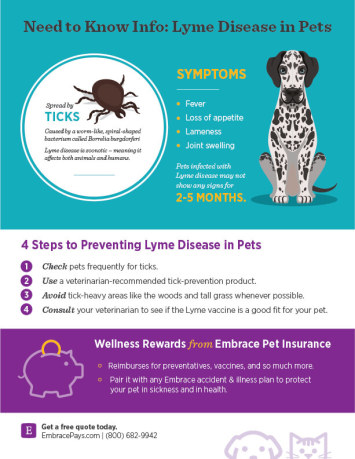
Does your dog love conquering new trails with you? Or playing fetch in the backyard? While those adventures are great bonding experiences, they can also come with an unwelcome hitchhiker—ticks. Lyme disease is one of those pesky zoonotic illnesses, meaning it can affect both animals and humans. Take preventative measures with your dogs and cats, by learning what Lyme disease is, from its transmission and symptoms to diagnosis, treatment, and prevention strategies. This way, you are safeguarding not just your pets but your entire household.
What is Lyme Disease and How is it Transmitted?
Lyme disease is caused by the bacterium Borrelia burgdorferi, primarily transmitted through the bite of infected black-legged ticks, also known as deer ticks. These ticks thrive in wooded areas, tall grasses, and marshy environments across the United States, particularly in the Northeast, Upper Midwest, and Pacific Coast regions.
While ticks live outside, they latch onto animals or humans who venture into their habitats. They can hitch a ride on your clothing or on your pet’s fur, to make their way into your home.
Can Humans Get Lyme Disease from Dogs?
It is a fact that both humans and dogs can contract Lyme disease, but it is important to know that you cannot get Lyme disease directly from your dog. The real risk comes from the infected ticks your dog might carry into your home. These ticks can bite you or other family members, potentially transmitting the disease. Therefore, ensuring your pet is protected from ticks not only safeguards their health but also reduces your own risk of exposure. Vigilance in tick prevention for your pet is the first step in protecting the whole household.
How to Recognize Symptoms of Lyme Disease in Dogs
Early detection of Lyme disease in dogs can also make a significant difference. Here are the common signs to watch out for:
Fever: An elevated body temperature can be an early warning.
Lameness or Joint Pain: Often shifting from leg to leg, this symptom is one of the most recognizable.
Swollen Lymph Nodes: Enlarged nodes could indicate an immune response to the infection.
Lethargy or Loss of Appetite: Reduced energy and lack of interest in food are common signs.
Stiff Walk with an Arched Back: Difficulty moving comfortably can signal joint pain.
Sensitivity to Touch: Unusual reactions to touch, like flinching or yelping.
Difficulty Breathing: In severe cases, respiratory issues might occur.
In rare and severe cases, Lyme disease can cause serious complications in dogs, including kidney failure, heart problems, or neurological issues. However, only about 5-10% of infected dogs develop noticeable symptoms. Because it can take two to five months for any signs of the disease to appear after infection, prioritizing year-round prevention is crucial for keeping your dog safe.
This extended incubation period underscores the importance of consistent preventative measures, even when your dog appears healthy.
Diagnosing and Treating Lyme Disease in Dogs
If you suspect your dog may have Lyme disease, it is essential to consult your veterinarian immediately. Diagnosis typically involves:
Physical Examination: A thorough check-up to identify visible signs.
Symptom Review: Your veterinarian will discuss your dog's symptoms with you and any recent tick exposure.
Blood Tests: They will perform a check for antibodies against B. burgdorferi.
Additional Testing: This is to rule out other conditions or to assess organ function.
Early diagnosis is vital to successful treatment and preventing long-term complications for your furry companion. Treatment often includes a course of antibiotics, typically doxycycline, for about 30 days or longer. Pain management medications might also be necessary, and in severe cases, additional supportive care to ensure recovery. Most dogs respond well to treatment, especially when caught early. However, some may experience recurring symptoms and require ongoing management.
Lyme disease, while treatable, can be expensive to diagnose and manage, especially if left undetected. Early diagnosis is key to preventing long-term complications, but blood tests, medication, and potential additional treatments can quickly add up. Pet insurance with a plan that covers Lyme disease can be a financial lifesaver in these situations.
Dog health insurance can reimburse expenses related to Lyme disease diagnosis and treatment, including blood tests, antibiotics, pain medication, and even specialist care in severe cases. This financial support allows you to prioritize your dog's health and well-being without worrying about the cost, giving you peace of mind while you focus on your furry friend's recovery. Remember, preventing Lyme disease is always the best approach, but having pet insurance provides an extra layer of security should your dog become infected.

Preventing Lyme Disease in Dogs
Prevention is the best approach to protecting your dog from Lyme disease. Here are the preventive measures you can follow to keep your furry friend safe:
Avoid tick-heavy areas: Steer clear of tall grass and wooded areas, when possible, especially during peak tick season (spring through fall).
Consider vaccination: Talk to your veterinarian to see if the Lyme vaccine is appropriate for your furry companion. It is particularly beneficial for dogs who spend a lot of time outdoors.
Use tick preventatives: Use a vet-recommended tick preventative that usually comes in various forms—chewables, collars, or topical treatments. (All of which can be claimed for reimbursement under our Wellness Rewards plan.)
Chewable: Usually meat-flavored, acting as a treat for your pet. It can also be wrapped in their favorite food so that they would eat it willingly.
Collars: Provides long-term protection and are water-resistant, suitable for dogs who love swimming.
Topicals: A liquid or get that is applied between the shoulder blades—but you may need to monitor your pets to prevent them from ingesting it.
Perform regular tick checks: After outdoor activities, thoroughly check your dog for ticks, focusing on areas like ears, neck, and between toes.
How to Remove Ticks from Your Dog?
If you still happen to find a tick on your four-legged friend, even after taking preventive measures, don’t panic. Instead, calmly remove it quickly and carefully, with these easy-to-follow steps:
Clean the Area: Start by using a cotton ball soaked in rubbing alcohol to clean around the tick bite. This prepares the skin and reduces the risk of infection.
Remove the Tick: Use a pair of fine-pointed tweezers—like those used for splinter removal rather than cosmetic ones. Grasp the tick as close to your dog’s skin as possible and pull straight up with steady, even pressure. Avoid twisting to ensure the entire tick is removed.
Sanitize Again: Once the tick is removed, clean the bite area again with rubbing alcohol to disinfect and soothe the skin.
Year-Round Vigilance with Preventative Care
While it is true that ticks are more active during warmer months, that does not mean they completely disappear in chilly weather. Ticks can still survive in temperatures as low as 32 degrees. In fact, with winters warming up in many places over the past few years, ticks are becoming more of a year-round concern. So regular tick checks after walks or playtime outdoors should be a part of your routine year-round.
Consider how you can make preventative care more accessible for your pet, with options like Embrace's optional, non-insurance Wellness Rewards plan. This plan can help budget for the costs of tick preventatives and Lyme disease vaccines. Invest in prevention now for a safer, healthier environment for your entire family.
Protect Your Pet from Lyme Disease
Don't let Lyme disease turn your pup's playtime into a health scare! With a little preparation, you can conquer those trails and explore the great outdoors with confidence. Remember, prevention is key – regular tick checks and year-round preventative measures are your best defense. Armed with knowledge and vigilance, you can keep your furry friend healthy and happy. Now, lace up your boots, grab your leash, and get out there – adventure awaits!